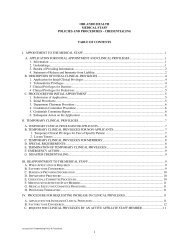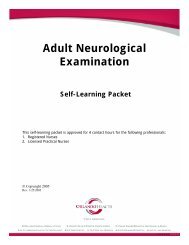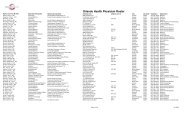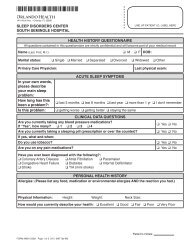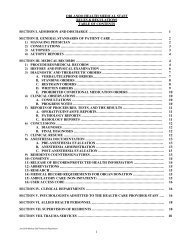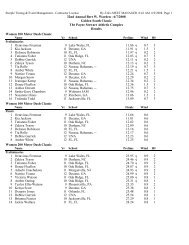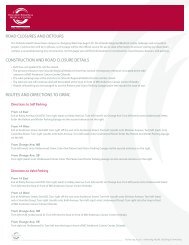Advanced Hemodynamics - Orlando Health
Advanced Hemodynamics - Orlando Health
Advanced Hemodynamics - Orlando Health
Create successful ePaper yourself
Turn your PDF publications into a flip-book with our unique Google optimized e-Paper software.
<strong>Advanced</strong> Hemodynamic Monitoring<br />
Components of the PAOP/PAWP waveform include:<br />
The A wave occurs after the QRS of the ECG complex. It reflects the increased left<br />
atrial pressure that occurs with left atrial contraction. Note that the A wave will be<br />
absent in patients who do not have a distinct atrial contraction, such as those with atrial<br />
fibrillation. Calculate the PAOP by averaging the pressure measured at the peak<br />
of the A wave and at the subsequent trough.<br />
The X descent reflects left atrial relaxation.<br />
The V wave reflects left atrial filling against a closed mitral valve.<br />
The Y descent reflects left atrial emptying associated with opening of the mitral valve<br />
(the onset of left ventricular diastole).<br />
Respiratory variation in PA waveform<br />
PAD-PAOP gradient<br />
Because there are no valves in the pulmonary arterial system when the PAC is wedged, it reflects an<br />
uninterrupted flow of blood to the left atrium. In other words, the tip of the catheter is able to see<br />
straight through the pulmonary circulation, because of the lack of valves, to the left atrium. So<br />
essentially during diastole the:<br />
LVEDP= left atrial pressure= pulmonary vascular pressure= PAOP.<br />
If that is so then the PAD pressure should closely correlate with the PAOP, with the PAD being<br />
slightly higher. The values should be no more than 4 mm Hg apart (PAD minus PAOP) to deem it<br />
Copyright 2010 <strong>Orlando</strong> <strong>Health</strong>, Education & Development 22




